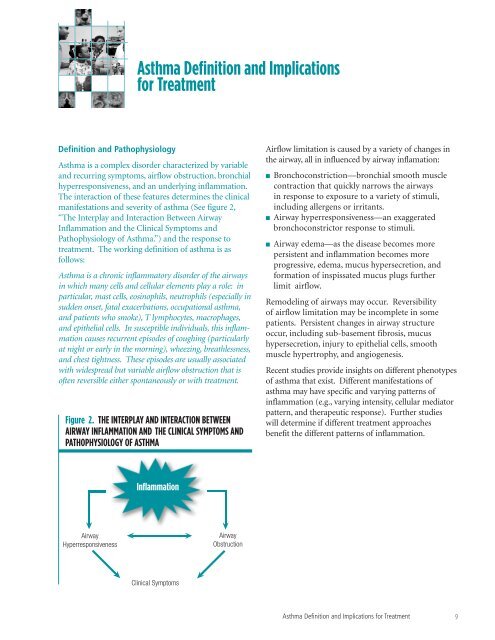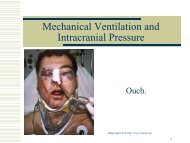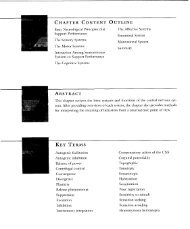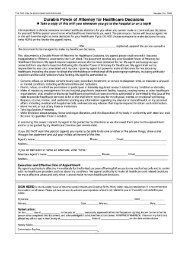Guidelines for the Diagnosis and Management of Asthma
Guidelines for the Diagnosis and Management of Asthma
Guidelines for the Diagnosis and Management of Asthma
Create successful ePaper yourself
Turn your PDF publications into a flip-book with our unique Google optimized e-Paper software.
<strong>Asthma</strong> Definition <strong>and</strong> Implications<br />
<strong>for</strong> Treatment<br />
Definition <strong>and</strong> Pathophysiology<br />
<strong>Asthma</strong> is a complex disorder characterized by variable<br />
<strong>and</strong> recurring symptoms, airflow obstruction, bronchial<br />
hyperresponsiveness, <strong>and</strong> an underlying inflammation.<br />
The interaction <strong>of</strong> <strong>the</strong>se features determines <strong>the</strong> clinical<br />
manifestations <strong>and</strong> severity <strong>of</strong> asthma (See figure 2,<br />
“The Interplay <strong>and</strong> Interaction Between Airway<br />
Inflammation <strong>and</strong> <strong>the</strong> Clinical Symptoms <strong>and</strong><br />
Pathophysiology <strong>of</strong> <strong>Asthma</strong>.”) <strong>and</strong> <strong>the</strong> response to<br />
treatment. The working definition <strong>of</strong> asthma is as<br />
follows:<br />
<strong>Asthma</strong> is a chronic inflammatory disorder <strong>of</strong> <strong>the</strong> airways<br />
in which many cells <strong>and</strong> cellular elements play a role: in<br />
particular, mast cells, eosinophils, neutrophils (especially in<br />
sudden onset, fatal exacerbations, occupational asthma,<br />
<strong>and</strong> patients who smoke), T lymphocytes, macrophages,<br />
<strong>and</strong> epi<strong>the</strong>lial cells. In susceptible individuals, this inflammation<br />
causes recurrent episodes <strong>of</strong> coughing (particularly<br />
at night or early in <strong>the</strong> morning), wheezing, breathlessness,<br />
<strong>and</strong> chest tightness. These episodes are usually associated<br />
with widespread but variable airflow obstruction that is<br />
<strong>of</strong>ten reversible ei<strong>the</strong>r spontaneously or with treatment.<br />
Figure 2. THE INTERPLAY AND INTERACTION BETWEEN<br />
AIRWAY INFLAMMATION AND THE CLINICAL SYMPTOMS AND<br />
PATHOPHYSIOLOGY OF ASTHMA<br />
Airflow limitation is caused by a variety <strong>of</strong> changes in<br />
<strong>the</strong> airway, all in influenced by airway inflamation:<br />
■ Bronchoconstriction—bronchial smooth muscle<br />
contraction that quickly narrows <strong>the</strong> airways<br />
in response to exposure to a variety <strong>of</strong> stimuli,<br />
including allergens or irritants.<br />
■ Airway hyperresponsiveness—an exaggerated<br />
bronchoconstrictor response to stimuli.<br />
■ Airway edema—as <strong>the</strong> disease becomes more<br />
persistent <strong>and</strong> inflammation becomes more<br />
progressive, edema, mucus hypersecretion, <strong>and</strong><br />
<strong>for</strong>mation <strong>of</strong> inspissated mucus plugs fur<strong>the</strong>r<br />
limit airflow.<br />
Remodeling <strong>of</strong> airways may occur. Reversibility<br />
<strong>of</strong> airflow limitation may be incomplete in some<br />
patients. Persistent changes in airway structure<br />
occur, including sub-basement fibrosis, mucus<br />
hypersecretion, injury to epi<strong>the</strong>lial cells, smooth<br />
muscle hypertrophy, <strong>and</strong> angiogenesis.<br />
Recent studies provide insights on different phenotypes<br />
<strong>of</strong> asthma that exist. Different manifestations <strong>of</strong><br />
asthma may have specific <strong>and</strong> varying patterns <strong>of</strong><br />
inflammation (e.g., varying intensity, cellular mediator<br />
pattern, <strong>and</strong> <strong>the</strong>rapeutic response). Fur<strong>the</strong>r studies<br />
will determine if different treatment approaches<br />
benefit <strong>the</strong> different patterns <strong>of</strong> inflammation.<br />
Inflammation<br />
Airway<br />
Hyperresponsiveness<br />
Airway<br />
Obstruction<br />
Clinical Symptoms<br />
<strong>Asthma</strong> Definition <strong>and</strong> Implications <strong>for</strong> Treatment<br />
9





